Skulls Unlimited cleans over 50,000 skulls a year.
Learn More!

Museum visitors bone up on knowledge, fun
Mar 25, 2011
ELAINE WARNER, The Edmond Sun
The Museum of Osteology.
Located at 10301 S. Sunnylane Road, the museum opened about six months ago and has quickly become a popular field-trip destination. This may be the most professional mom-and-pop attraction I’ve seen outside of Kansas City’s Arabia museum.
Founder Jay Villamarette has been interested in skeletons ever since, at age 7, he found a dog skull. His father noted his interest and encouraged it. By sixth grade, he entered his small collection in his school’s science fair where it received a superior rating. The next year, he entered it in the State Fair, taking home a fifth-place ribbon.
For years, collecting skulls remained a hobby. Pursuing a career as an auto body technician, collecting was a spare-time activity until he discovered a market for specimens. He and his wife Kim began cleaning skulls in their kitchen and started a business, Skulls Unlimited, in 1986.
As the company’s reputation grew, so did the business. Universities and museums around the world provide a healthy customer base. In case you were wondering, specimens come from natural and predator deaths, road kill, etc. — legal and ethical sources of skeletons. With success came the desire to share and to educate — hence, the museum.
The museum skips lightly, thank goodness, over the process of cleaning the specimens. The closest it gets is a small case featuring the dermestid carrion beetles who do the last little bit of cleaning. Mike Rowe of the Discovery Channel’s “Dirty Jobs” went into much more detail on the show. ’Nuff said.
The museum itself is bright, clean and pristine and practically a textbook of vertebrate biological classification. A few invertebrate specimens are included to show the difference between exo- and endoskeletons. Most of the collection consists of mammals but there are some representatives of the other main types of vertebrates — reptiles, amphibians, fish and birds.
Even before we got through the door into the museum proper, the boys were measuring themselves against the two whale skulls which flank the entrance. Upon entering the main hall, our attention immediately went to the hulking whale skeleton suspended from the ceiling. Even with just the bones, this behemoth humpback weighs over a ton and stretches 40 feet long.
On the floor are several elephant skulls, an entire African elephant skeleton, a giraffe, a hippopotamus and a white rhino. Children are invited to touch — gently — the bones, the hippo teeth and the rhino’s horn. Another exhibit elsewhere in the museum explains the difference between horns and antlers.
The rarest skull in the collection is the skull of a Javan rhinoceros. It is estimated that between 30 and 50 of these animals remain in the wild. Jay found this skull, from an animal killed in the late 1800s, in an antique shop in Paris.
Almost all the skulls and skeletons in the museum are from animals that can still be found in the wild or in zoos. One stunning exception is a display which includes early hominid skulls. One of my favorite displays features the apes of the primate order. Standing casually at the back of the display is a human skeleton — genus homo sapiens.
This museum is so well done that you’d have to try hard not to learn something while simply enjoying the exhibits. The museum is open Monday through Friday from 9 a.m. to 5 p.m. and Saturday from 11 a.m. to 4 p.m. Admission is $5; children under 3 — one free with one adult ticket purchase.
Make no bones about it — this museum is a winner!
ELAINE WARNER is an Edmond resident.

Leave a comment